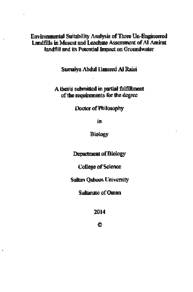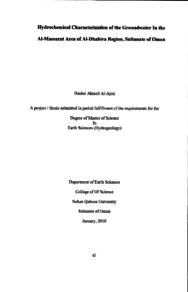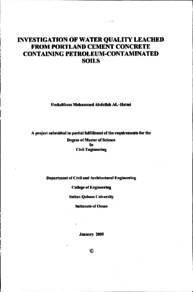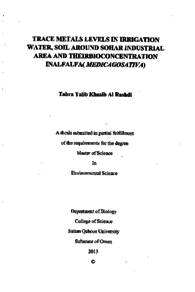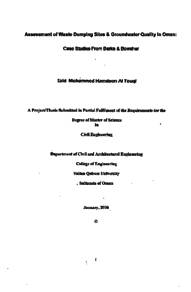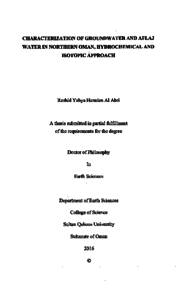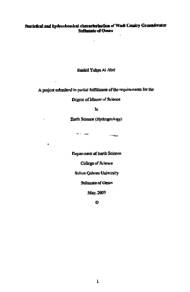Document
Environmental suitability analysis of three un-engineered landfills in Muscat and leachate assessment of Al Amirate landfill and its potential impact on groundwater
Publisher
Sultan Qaboos University
Gregorian
2014
Language
English
Subject
English abstract
The amount of waste generated each year is increasing. Sultanate of Oman produces about 1 million tons of waste per year. The un-engineered landfills used for waste disposal in the Sultanate lack gas and leachate collection systems. Moreover, most of these landfill sites lack the main criteria required for landfill site selection such as vicinity of sites to residential areas. The main complaints about these landfills are due to population movement towards the site, continuous flaring and leachate flow in wadies. For example, the closest house to Al Amirat landfill is only 300 m away. These problems can be tackled from the beginning by proper site selection. Therefore, the main objectives of this study are to determine the environmental suitability of three un-engineered landfills in Muscat (Al Amirat, Al Mabella and Bousher) using multi criteria decision analysis, to assess leachate of Al Amiratunengineered landfill and to identify its potential impact on groundwater and soil in vicinity to the landfill site. Leachate, groundwater and soil samples were collected and analyzed using the standard methods. Ninety parameters were used for leachate and groundwater analysis. Although all the studied landfills are vulnerable due to the lack of proper design, the landfill site suitability analysis has showed that Al Amirat un-engineered landfill is the most suitable site for waste disposal practices (Score: 0.375) in comparison to Al Mabella and Bousher landfill sites due factors like the geological setup of the area. Moreover, the assessment of leachate of the same landfill has showed a complex nature. The leachate was polluted with elevated concentrations of chlorides (Average: 6710 mg/l), Na (Average: 5380 mg/l), heavy metals (AI, V, Cr, Mn, Co, Ni, Cd, Ba, Pb and Fe), volatile fatty acids (Maximum: 173.8 mg/l), ammonia (Maximum: 990 mg/l), Poly chlorinated biphenyles (PCBs) (Maximum: 1.4 mg/l), organochlorine pesticides (Maximum: 0.083 mg/l), phthalates (1.615 mg/l) and coliforms (Maximum: 9300 MPN/100ml) which were exceeding the Omani waste water re-use and discharge standards. The presence of heavy metals in leachate along with hazardous organic contaminants is a direct indicator of disposal of hazardous wastes in the landfill which might be of household origin. Furthermore, the leachate pollution index (LPI: 26.33 to 27.67) of Al Amirat landfill leachate indicates contamination and thus proper treatment is required before discharge. The high organic content of waste in Oman (60%) has leadto the production of high organic strength leachate. Al Amirat landfill was found to be highly biodegradable (Biodegradability: 3 – 4.6). Moreover, its leachate composition reflects characteristics of different stages of landfill decomposition and heterogeneity of waste. Boreholes construction, rock porosity analysis (1.38% porosity) and soil textural class analysis (Sandy clay loam) have showed very low permeability and porosity indicating either no groundwater or very limited groundwater resources at Al Amirat landfill site. In addition, the groundwater evaluation in the area has showed that the upstream groundwater wells were contaminated. The concentrations of parameters like total dissolved solids (TDS), electrical conductivity (EC), chlorides, nitrates, sulfates, bicarbonates, Mg, Na, Fe, coliforms were considerably high, exceeding the Omani drinking water standards. Xenobiotic contaminants were detected in concentrations less than 0.1 mg/l in the groundwater samples. Theseresults indicate that leachate may not be the sole source of contamination of groundwater in the area surrounding Al Amirat landfill. Natural and anthropogenic sources of contamination may exist like rock weathering, evaporation, domestic sewage and agricultural practices in the area. Furthermore, soil assessment has indicated that soil samples in vicinity to Al Amirat landfill do not pose any toxicity as it is not considered hazardous, but since most of the metals show mobility within the soil profile, an effect on groundwater might occur on the long run if no action is taken to prevent it. Knowledge of the fate of these pollutants in these multicopartment heterogeneous landfills is poor and cannot be predicted, making it difficult to assess its environmental risks. Therefore, any adverse impacts on the environment should be minimized by sucking out the leachate by means of newly constructed boreholes and transferring it from pools and boreholes to specialized treatment facilities with continuous monitoring of leachate quality and quantity. Thus, the findings of this study highlight the importance of multicriteria decision analysis in landfill site selection to prevent any vulnerability to the environment from landfills. The criteria used in this study should be considered and buffer distances should be established and maintained by decision makers in order to carry out assessment studies on different existing landfill sites and to select the most suitable sites for future landfills in order to reduce any potential impacts on the environment. Rehabilitation of such old un-engineered landfills should take place with continuous monitoring programs of groundwater resources in the area. Further investigations of pollution sources of groundwater should be conducted and criteria for use of such quality of groundwater should be set. Standards including the parameters studied should be established and implemented and regulations should be set by regulatory bodies in the country regarding treatment and final discharge of leachate and closure of landfills. Also, legislations regarding protection of environment and water resources should be implemented in order to prevent pollution and protect the environment.
Member of
Resource URL
Arabic abstract
ان كمية المخلفات التي يتم انتاجها سنويا في تزايد. تنتج سلطنة عمان حوالي مليون طن من المخلفات سنويا. تفتقر مواقع الطمر الشائعة في السلطنة إلى المواصفات الهندسية كأنظمة جمع الغازات و العصارة. علاوة على ذلك، فإن معظم هذه المواقع تفتقر إلى المعايير البيئية الرئيسية اللازمة لاختيار مواقع الطمر، حيث تقع مواقع الطمر في مسقط بالقرب من المناطق السكنية. معظم الشكاوي حول هذه المواقع تتمحور حول حركة السكان باتجاه الموقع والاحتراق الذاتي المستمر وتكون العصارة. من الممكن تفادي هذه المشاكل منذ البداية من خلال اختيار موقع مناسب لطمر المخلفات حسب المعايير البيئية اللازمة. لذلك، فان اهداف هذه الدراسة هي تحليل مدى الملاعمة البيئية لثلاث مواقع لطمر المخلفات في مسقط (العامرات و المعبيلة و بوشر باستخدام معايير متعددة لتحديد القرار يليها تقييم العصارة لموقع العامرات للطمر. بالاضافة الى ذلك، تقييم نوعية المياه الجوفية والتربة في المنطقة المحيطة بموقع الطمر في العامرات حيث تم جمع عينات من العصارة والمياه الجوفية والتربة وتحليل ۹۰ معيارا باستخدام الأساليب القياسية. وقد أظهرت النتائج بانه بالرغم من عدم ملائمة جميع المواقع التي تم دراستها من حيث تصميم الموقع، الا أن موقع العامرات هو الموقع الأكثر ملائمة للتخلص من المخلفات عن طريق الطمر (النتيجة: ۰٫۳۷۵) بالمقارنة مع موقعي المعبيلة وبوشر لطمر المخلفات بسبب عوامل كالمواصفات الجيولوجية للمنطقة. بالاضافة الى ذلك، فقد أظهرت تحاليل تقييم العصارة الموقع العامرات طبيعة معقدة للعصارة، حيث انها ملوثة بتركيزات مرتفعة من الكلوريدات (متوسط: 6۷۱۰ ملغم / لتر)، والصوديوم (5۳۸۰ ملغم / لتر)، والمعادن الثقيلة (الالمنيوم، الفاناديوم، الكروم، المنغنيز، الكوبالت النيكل، الكادميوم، الباريوم، الرصاص، الحديد) و والأحماض الدهنية المتطايرة (الحد الأقصى: ۱۷۳٫۸ ملغم / لتر) والأمونيا (الحد الأقصى: ۹۹۰ ملغم / لتر)، وثنائي الفينيل متعدد الكلور (الحد الأقصى: ۱٫4 ملغم / لتر) والمبيدات الحشرية الكلورية العضوية (الحد الأقصى: ۱٬۰۸۳ ملغم / لتر) و الفتالات (۱٫۹۱۵ ملغم / لتر) و القولونيات ( الحد الأقصى للعدد المحتمل: ۹۳۰۰/ ۱۰۰ مل) التي تجاوزت تركيزاتها معايير اعادة استخدام المياه العادمة وتصريفها في سلطنة عمان. آن وجود المعادن الثقيلة في العصارة الى جانب الملوثات العضوية الخطرة هي مؤشرات مباشرة للتخلص من المخلفات الخطرة في الموقع والتي قد تكون منزلية المصدر. بالاضافة الى ذلك، فإن تحليل مؤشر تلوث العصارة ( ۲۹, ۳۳ – ۲۷ , ۹۷ ) في موقع العامرات يشير الى وجود تلوث وبالتالي يترتب معالجة العصارة قبل التخلص منها. من الجدير بالذكر، أن ارتفاع نسبة المخلفات العضوية في السلطنة (60٪) قد أدى إلى إنتاج عصارة عالية العضوية، حيث اثبتت النتائج بأن هذا الموقع ذو قابلية عالية للتحلل البيولوجي (التحلل البيولوجي: 3-4 , 6 ). علاوة على ذلك، فإن تكوين العصارة يعكس خصائص مراحل مختلفة من التحلل في الموقع وعدم تجانس المخلفات الى جانب ذلك، فان حفر الآبار وتحليل مسامية الصخور المسامية: ۱٫۳۸ ٪) وتحليل التربة قد أظهر انخفاض نسبة النفاذية والمسامية مما يشير إلى عدم وجود مياه جوفية أو أن موارد المياه الجوفية محدودة جدا في الموقع. من جانب آخر، فقد أظهرت تحاليل المياه الجوفية البعض الآبار في المنطقة المحيطة بالموقع ان تراكيز بعض المعايير كالمواد الصلبة الذائبة والتوصيل الكهربائي و الكلوريدات والنترات والكبريتات والبيكربونات، والمغنيسيوم و الصوديوم و الحديد و القولونيات في عينات المياه الجوفية أعلى موقع الطمر قد تجاوزت معايير مياه الشرب العمانية. ان ارتفاع نسب المعايير المذكورة و وجود الملوثات العضوية يشير الى وجود مصادر اخرى لارتفاع هذه التراكيز وأن العصارة قد لا تكون المسبب الرئيسي لارتفاع هذه التراكيز في آبار المياه الجوفية في المنطقة. هذه المصادر قد تكون طبيعية أو بشرية المنشا كتحلل الصخور والتبخر وتسرب مياه الصرف من المنازل والممارسات الزراعية في المنطقة. بالاضافة الى ذلك، فقد أشارت نتائج تقييم التربة الى أن عينات التربة في المنطقة المجاورة لموقع الطمر لا تشكل أي سمية ولكن انتقال المعادن خلال طبقات التربة قد يؤدي إلى حدوث تأثيرات على المياه الجوفية على المدى الطويل إذا لم يتم اتخاذ أي إجراء لمنع ذلك. للملوثات في مواقع الطمر مصادر مختلفة. أن عدم معرفة مصير هذه الملوثات في مواقع الطمر يجعل تقييم المخاطر البيئية صعبا. وبالتالي، ينبغي الحد من اي تاثيرات على البيئة من خلال امتصاص العصارة عن طريق بناء آبار وتحويل العصارة من الأحواض الى مرافق المعالجة على أساس منتظم مع تقييم دوري لنوعية وكمية العصارة حيث ينبغي ايجاد الطرق المثلى لمعالجة العصارة اخذين بعين الاعتبار المعايير التي تم معاينتها في هذه الدراسة. بالاضافة إلى إعادة تأهيل مواقع طمر المخلفات المغلقة مع تنفيذ برامج الرصد المستمر لمصادر المياه الجوفية. كما ينبغي دراسة مصادر تلوث المياهالأخرى في المنطقة ووضع ضوابط لاستخدامات المياه الجوفية في المنطقة. أن نتائج هذه الدراسة تسلط الضوءعلى أهمية تحليل تحديد القرار متعدد المعايير في اختيار مواقع الطمر لمنع أي اثار على البيئة، حيث ينبغي النظر في المعايير المستخدمة في هذه الدراسة من قبل صانعي القرار من أجل إجراء دراسات التقييم على مختلف مواقع طمر المخلفات القائمة ودراسة اثارها على البيئة، وكذلك لتحديد المواقع الأكثر ملاءمة لطمر المخلفات في المستقبل للحد من اثار هذه المواقع على البيئة. كما ينبغي سن القوانين واتخاذ الاجراءات اللازمة بشأن معالجة والتخلص النهائي من العصارة واغلاق مواقع الطمر والتي من شانها تقليل الاثار البيئية لمثل هذه المواقع، بالاضافة الى الحرص على تنفيذ القوانين واللوائح الخاصة بالحفاظ على البيئة وحماية المياه من التلوث وذلك لحماية البيئة و مصادر المياه.
Category
Theses and Dissertations

